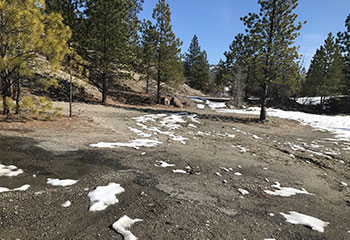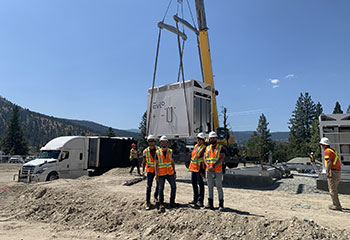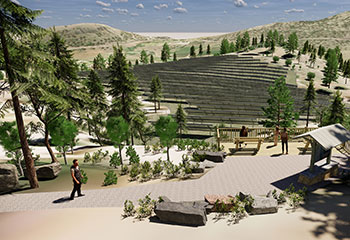
Summary
The District of Summerland, B.C., operates its own electrical utility and is enhancing its support for a transition to net-zero. They pinpointed a municipally owned brownfield as a viable location for a solar and storage facility. With GMF-backed studies, they verified its suitability for cleanup and solar panel installation, accomplishing two sustainability goals simultaneously.
Background

The District of Summerland, a 12,000-resident municipality in south-central British Columbia, operates its own electrical utility. This local control enables reliable, resilient and net-zero-aligned power sourcing. One of their initiatives is establishing a solar and storage facility for renewable energy.
With funding from the Federal Gas Tax Fund (now the Canada Community-Building Fund), the district initiated their solar project, choosing a 10.4-hectare brownfield site, used as a public works yard until 1970, located southwest of downtown Summerland.
The challenge
The district needed to find out whether this site would be a good choice for their solar and storage facility and thus achieve two solutions at once: redeveloping a brownfield while also creating a new source of renewable energy. They successfully applied for a brownfield site redevelopment grant from GMF to determine the site’s suitability and how much cleanup would be required.
Approach

The GMF grant funded two studies:
- A preliminary site investigation (PSI) to examine the site’s water and soil for the presence or absence of contaminants. This process included soil collection, groundwater monitoring and the use of boreholes.
- A geotechnical analysis to assess soil, slopes and groundwater conditions in the proposed location for the solar panels. This stage included determining the best way to remove asbestos materials from the site.
Reports from these studies were completed with an eye to guiding the full redevelopment plan.
Results
The studies showed that the brownfield site was suitable for a solar and storage installation and that there was no appreciable contamination of soil or water on the site. The only hazardous materials that needed to be removed were the pipes present, which contained asbestos, and remnant concrete structures. The geotechnical study also provided guidance on stormwater management and made construction recommendations related to the soil analysis.
Benefits

The brownfield is close to a viewpoint and cultural site significant to the Penticton Indian Band. Conducting studies prior to the solar and storage facility’s installation ensured minimal impact on this site and nearby recreational trails. Besides preserving the viewpoint, the municipality plans to accentuate it with a plaque, viewing platform and native plant landscaping.
Economically, the solar and storage facility will reduce the district's electrical costs by roughly $250,000 annually, decreasing energy purchases from Fortis BC during peak rates. These savings will be reinvested in the community, enhancing electrical infrastructure and supporting more projects.
Local businesses benefitted from construction and solar installation, with battery storage sourced from a firm in Quebec. Additionally, the solar site serves as an educational resource on major solar initiatives.
Lessons learned
The municipality was pleased with some of the decisions they made for this project and would recommend the following advice to others undergoing similar studies:
- Hire an external consultant to develop the scope of work for their RFP and be part of the evaluation team
- Have third-party experts on board to assist with understanding technical requirements and questions
- Combine the PSI and geological phases for cost savings
- Ensure the initial contract specifies report copyrights, permitting sharing and republishing by the municipality and partners like FCM to foster transparency.
Next steps
Following the completion of these studies, Summerland issued an RFP for construction of their solar project. The panels and batteries have all been installed and the project is expected to launch by the end of 2023.
Want to explore all GMF-funded projects? Check out the Projects Database for a complete overview of funded projects and get inspired by municipalities of all sizes, across Canada.

